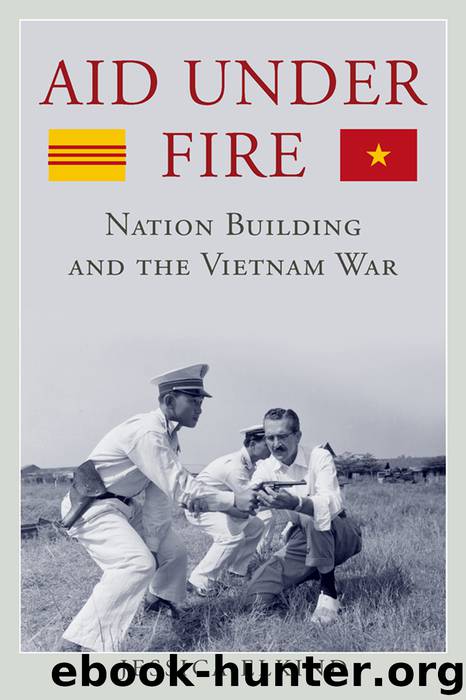Aid under Fire by Elkind Jessica;

Author:Elkind, Jessica;
Language: eng
Format: epub
Publisher: University Press of Kentucky
Published: 2016-03-17T16:00:00+00:00
The Civil Guard Dispute
Perhaps the MSU police advisers’ most significant failure derived from their inability to convince Vietnamese officials to embrace their recommendations for the civil guard. Their protracted conflict with the GVN and the US government over the future of the civil guard reflected a shift in official American policy in South Vietnam toward increased militarization. This conflict also contributed significantly to MSU’s gradual loss of authority over police operations in the country and foreshadowed the American involvement in the ground war.
According to the MSU group’s vision, the civil guard would be a professional law enforcement agency with guardsmen outfitted with and trained to use “modern mobile communications and firearm equipment.” The police team modeled its recommendations on state police forces in the United States. It expected the organization to operate locally and with some autonomy while adhering to national laws and regulations. The American advisers hoped that members of the civil guard would “become a part of the community in which they live” rather than a force sent from Saigon to the provinces during difficult periods.53
However, the university advisers were not naive about the rapidly increasing level of violence in the Vietnamese countryside. They anticipated situations in which a regular civil police organization might be unable to preserve peace and order. Therefore, they advised that the civil guard train some elite companies that would be more mobile and have the ability to strike harder than regular guardsmen. The government could dispatch these companies to respond to trouble spots or particularly grave threats to internal security. Because they must remain available to be sent anywhere in the country, these units would not likely become integrated into the community. However, like all units of the guard, they were to consist entirely of civilians and would be forbidden from using military tactics. According to the MSU police team, if internal security reached the point of emergency, the president could then call in the military at his own discretion.54
The clear distinction between the civil guard and the Vietnamese military, as well as the separation of the duties and powers of these two groups, lay at the heart of the MSU group’s diagnosis of how to improve law enforcement in South Vietnam. The police team insisted that civilian police organizations, rather than the military, handle all matters of internal security. On this point it held firm, even when Diem and other American advisory groups advocated militarizing the police forces. During their time in Vietnam, the MSU police advisers came under pressure from Diem and MAAG to convert the civil guard into a national paramilitary group.
The different visions for the civil guard offered by the MSU group and USOM, on the one hand, and the GVN and American military leaders, on the other, stemmed from the two sides’ divergent diagnoses of Vietnam’s security problems as well as their conflicting political ideologies. In particular, the MSU team expressed ideas about the relationship between the police and state building that differed radically from those of the GVN and MAAG.
Download
This site does not store any files on its server. We only index and link to content provided by other sites. Please contact the content providers to delete copyright contents if any and email us, we'll remove relevant links or contents immediately.
| Arms Control | Diplomacy |
| Security | Trades & Tariffs |
| Treaties | African |
| Asian | Australian & Oceanian |
| Canadian | Caribbean & Latin American |
| European | Middle Eastern |
| Russian & Former Soviet Union |
The Secret History by Donna Tartt(16627)
The Social Justice Warrior Handbook by Lisa De Pasquale(11489)
Thirteen Reasons Why by Jay Asher(7788)
This Is How You Lose Her by Junot Diaz(5774)
Weapons of Math Destruction by Cathy O'Neil(5037)
Zero to One by Peter Thiel(4824)
The Myth of the Strong Leader by Archie Brown(4789)
Promise Me, Dad by Joe Biden(4449)
Beartown by Fredrik Backman(4419)
Stone's Rules by Roger Stone(4416)
How Democracies Die by Steven Levitsky & Daniel Ziblatt(4399)
The Fire Next Time by James Baldwin(4343)
100 Deadly Skills by Clint Emerson(4079)
A Higher Loyalty: Truth, Lies, and Leadership by James Comey(4033)
Rise and Kill First by Ronen Bergman(4012)
The David Icke Guide to the Global Conspiracy (and how to end it) by David Icke(3883)
The Farm by Tom Rob Smith(3872)
Secrecy World by Jake Bernstein(3783)
The Doomsday Machine by Daniel Ellsberg(3731)
